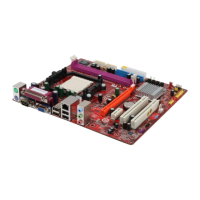
Do you have a question about the PC Chips A15g and is the answer not in the manual?
| Brand | PC Chips |
|---|---|
| Model | A15g |
| Category | Motherboard |
| Language | English |
Overview of the motherboard's main capabilities and specifications.
Lists the items included in the motherboard's retail package.
Identifies and describes the main parts and connectors on the motherboard.
Step-by-step guide for safely installing the CPU onto the motherboard socket.
Instructions for inserting DDR2 SDRAM modules into the DIMM slots.
Explains the function and configuration of various jumpers on the motherboard.
Guidance on physically mounting the motherboard into a computer chassis.
Details on connecting front panel headers and other optional devices.
Instructions for installing floppy drives, IDE devices, and other system components.
Information on available PCI Express and PCI slots for expansion cards.
Explains the purpose and function of the BIOS Setup Utility.
How to access and navigate the BIOS setup interface.
Configures basic system settings like date, time, and IDE/SATA devices.
Advanced system configuration options, including CPU and chipset settings.
Settings related to DRAM frequency, timing, and VGA memory allocation.
Enables/disables onboard controllers like IDE, SATA, Audio, and LAN.
Configures system power states, wake-up events, and ACPI settings.
Manages PCI and Plug and Play device configurations.
Monitors system voltages, temperatures, and fan speeds.
Adjusts CPU and memory clock speeds and voltages.
Resets BIOS settings to optimized factory defaults.
Sets or changes the administrator password for BIOS access.
Sets or changes the user-level password for BIOS access.
Saves current BIOS settings and exits the setup utility.
Discards any changes made and exits the BIOS setup utility.
Describes the contents of the support DVD-ROM/CD-ROM.
Guide for installing drivers and utility software from the included disc.
Steps to install specific bundled software applications.
Creates RAID arrays for backup or performance without OS modification.
Configures RAID arrays during OS installation for bootable arrays.
Installs necessary drivers and software for RAID management in Windows.
Steps to define RAID type and assign disks within the RAID BIOS utility.
Troubleshooting steps for power-related issues and fan operation.
Diagnosing issues when the system powers on but shows no video output.
Addresses sudden system shutdowns during the boot process, often due to overheating.
Resolving issues that may arise after extended periods of system operation.
Basic guidelines for maintaining the motherboard and computer system.
